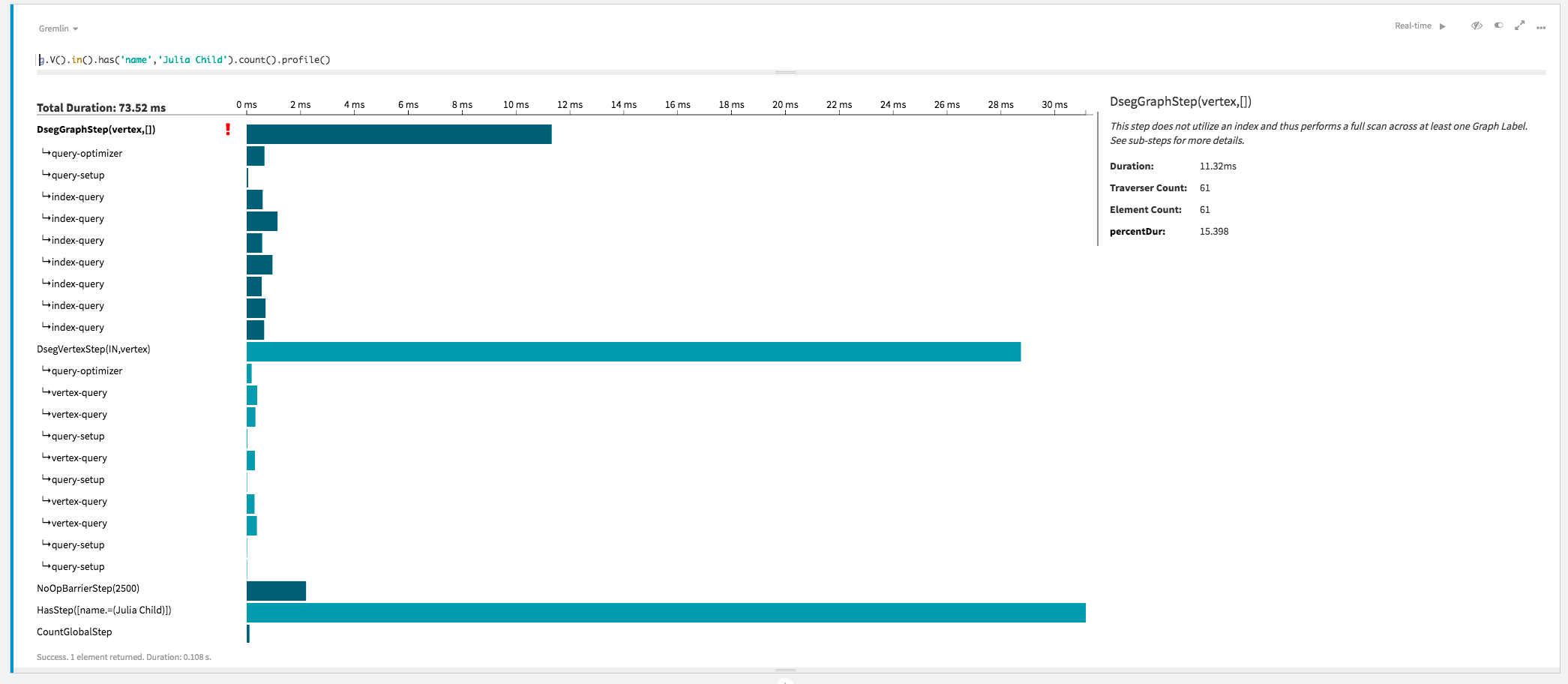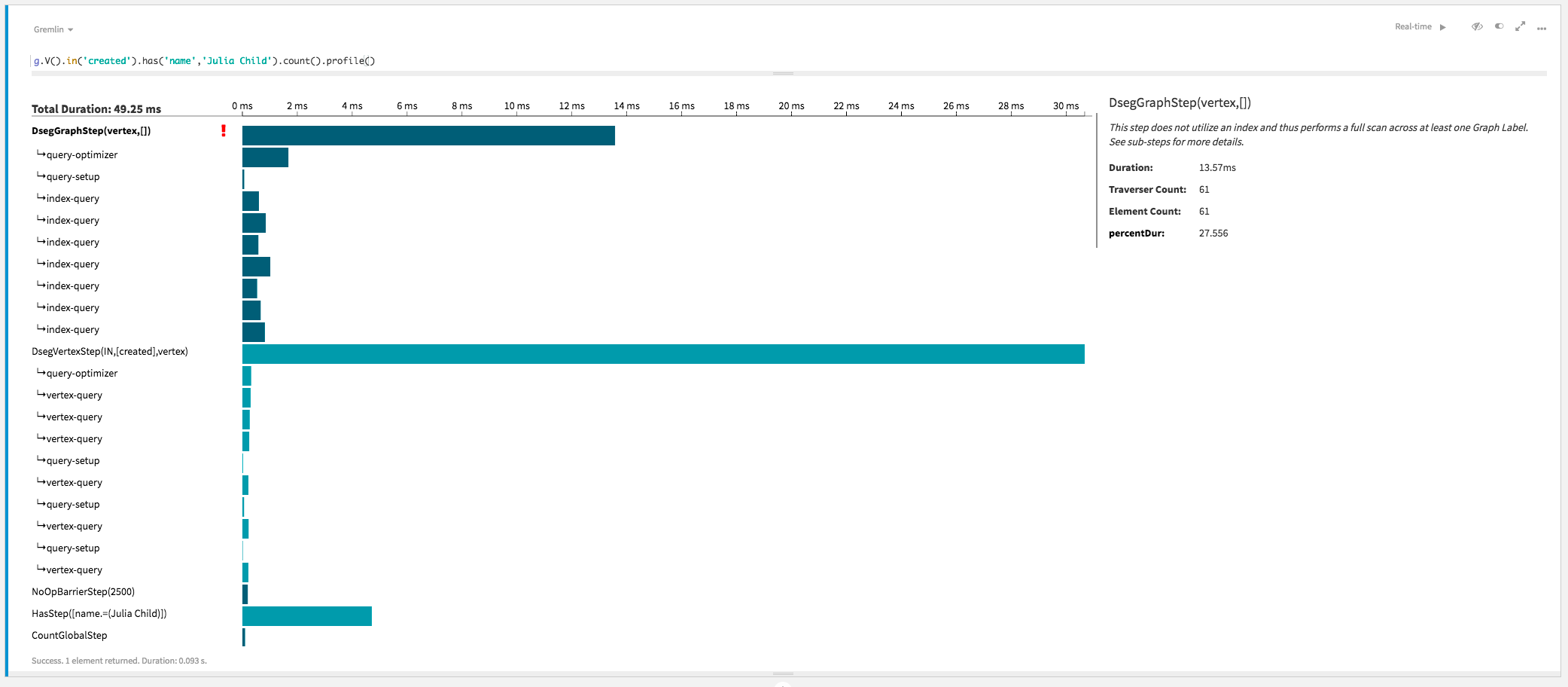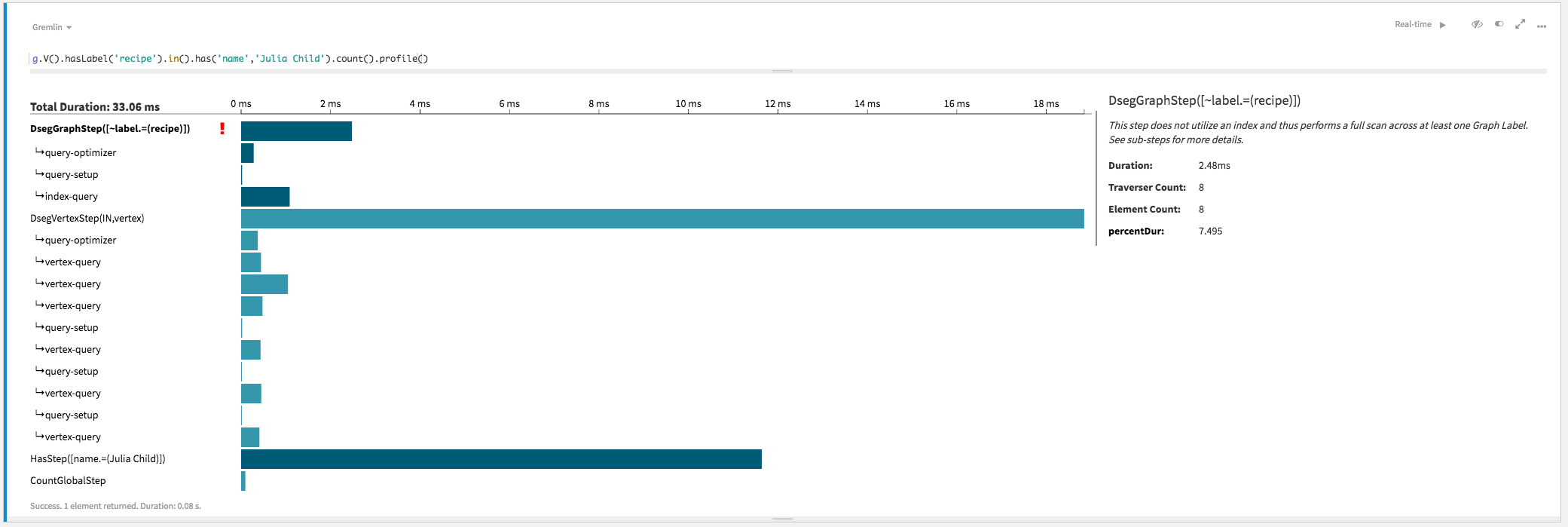DSE Graph, OLTP, and OLAP
Online transactional processing (OLTP) is characterized by a large number of short, online transactions for very fast query processing. OLTP is typically used for data entry and retrieval with transaction-oriented applications. Online analytical processing (OLAP) is typically used to perform multidimensional analysis of data, doing complex calculations on aggregated historical data.
OLTP applications require sub-second response times, whereas OLAP applications take much longer to finish queries. Graph databases are a random access data system. In these databases, OLAP traversals do a linear scan of all vertices in the graph. Conversely, OLTP traversals are localized to a particular subgraph of the global graph. OLTP traversals leverage indexes to "jump" in to a particular vertex in the graph before starting a scan on the subgraph.
OLTP queries
OLTP queries are best for questions that require access to a limited subset of the entire graph. OLTP queries use filters to limit the number of vertices that will be walked to find answers. DSE Graph co-locates vertices with their edges and adjacent neighbors. When a subgraph is specified in a traversal using indexes, the number of requests to disk are reduced to locate and write the requested subgraph to memory. Once in memory, the traversal performs a link walk from vertex to vertex along the edges.
OLAP queries
OLAP queries are best for questions that must access a significant portion of the data stored in a graph. Using the previous method to evaluate OLAP queries will not be efficient, so a different process is used. When OLAP queries are processed, the entire graph is interpreted as a sequence of star graphs, each composed of a single vertex, along with its properties, incident edges, and the edges' properties. The star graphs are linearly processed, jumping from one star graph to the next until all star graphs are processed and an aggregation of the discovered data is completed.
Principles for writing graph traversals
Understanding these underlying principles can lead to writing better graph traversals to query the graph data. A simple example illustrates the differences. Using the food graph, the query is “How many recipes has Julia Child created?”
Consider the following graph traversal:
g.V().in().has('name','Julia Child').count()
===>6This traversal completes the following processing:
-
Looks at all vertices.
-
Walks the incoming edges.
-
Finds the adjacent vertices that have the property key of
nameand property value ofJulia Child. -
Counts the number of vertices.
This graph traversal is a classic OLAP traversal, which must touch all vertices and does not use indexing. The count returned includes all vertices with edges to Julia Child, and not just the recipes, so as shown later, the count is incorrect and too high.
Consider the number of elements that must be traversed to complete this query. DSE Graph has profiling that aids in analyzing the traversal:
gremlin> g.V().in().has('name','Julia Child').count().profile()
==>Traversal Metrics
Step Count Traversers Time (ms) % Dur
=============================================================================================================
DsegGraphStep(vertex,[]) 61 61 28.932 18.71
query-optimizer 0.563
_condition=((label = FridgeSensor | label = author | label = book | label = ingredient | label = meal |
label = recipe | label = reviewer) & (true))
query-setup 0.048
_isFitted=true
_isSorted=false
_isScan=true
index-query 0.979
_usesCache=false
_statement=SELECT "city_id", "sensor_id" FROM "DSEQuickStart"."FridgeSensor_p" WHERE "~~vertex_exists" =
? LIMIT ? ALLOW FILTERING; with params (java.lang.Boolean) true, (java.lang.Integer) 50000
_options=Options{consistency=Optional[ONE], serialConsistency=Optional.empty, fallbackConsistency=Option
al.empty, pagingState=null, pageSize=-1, user=Optional.empty, waitForSchemaAgreement=true, asyn
c=true}
index-query 0.862
_usesCache=false
_statement=SELECT "community_id", "member_id" FROM "DSEQuickStart"."author_p" WHERE "~~vertex_exists" =
? LIMIT ? ALLOW FILTERING; with params (java.lang.Boolean) true, (java.lang.Integer) 50000
_options=Options{consistency=Optional[ONE], serialConsistency=Optional.empty, fallbackConsistency=Option
al.empty, pagingState=null, pageSize=-1, user=Optional.empty, waitForSchemaAgreement=true, asyn
c=true}
index-query 0.679
_usesCache=false
_statement=SELECT "community_id", "member_id" FROM "DSEQuickStart"."book_p" WHERE "~~vertex_exists" = ?
LIMIT ? ALLOW FILTERING; with params (java.lang.Boolean) true, (java.lang.Integer) 50000
_options=Options{consistency=Optional[ONE], serialConsistency=Optional.empty, fallbackConsistency=Option
al.empty, pagingState=null, pageSize=-1, user=Optional.empty, waitForSchemaAgreement=true, asyn
c=true}
index-query 1.344
_usesCache=false
_statement=SELECT "community_id", "member_id" FROM "DSEQuickStart"."ingredient_p" WHERE "~~vertex_exists
" = ? LIMIT ? ALLOW FILTERING; with params (java.lang.Boolean) true, (java.lang.Integer) 5000
0
_options=Options{consistency=Optional[ONE], serialConsistency=Optional.empty, fallbackConsistency=Option
al.empty, pagingState=null, pageSize=-1, user=Optional.empty, waitForSchemaAgreement=true, asyn
c=true}
index-query 1.053
_usesCache=false
_statement=SELECT "community_id", "member_id" FROM "DSEQuickStart"."meal_p" WHERE "~~vertex_exists" = ?
LIMIT ? ALLOW FILTERING; with params (java.lang.Boolean) true, (java.lang.Integer) 50000
_options=Options{consistency=Optional[ONE], serialConsistency=Optional.empty, fallbackConsistency=Option
al.empty, pagingState=null, pageSize=-1, user=Optional.empty, waitForSchemaAgreement=true, asyn
c=true}
index-query 4.173
_usesCache=false
_statement=SELECT "community_id", "member_id" FROM "DSEQuickStart"."recipe_p" WHERE "~~vertex_exists" =
? LIMIT ? ALLOW FILTERING; with params (java.lang.Boolean) true, (java.lang.Integer) 50000
_options=Options{consistency=Optional[ONE], serialConsistency=Optional.empty, fallbackConsistency=Option
al.empty, pagingState=null, pageSize=-1, user=Optional.empty, waitForSchemaAgreement=true, asyn
c=true}
index-query 1.291
_usesCache=false
_statement=SELECT "community_id", "member_id" FROM "DSEQuickStart"."reviewer_p" WHERE "~~vertex_exists"
= ? LIMIT ? ALLOW FILTERING; with params (java.lang.Boolean) true, (java.lang.Integer) 50000
_options=Options{consistency=Optional[ONE], serialConsistency=Optional.empty, fallbackConsistency=Option
al.empty, pagingState=null, pageSize=-1, user=Optional.empty, waitForSchemaAgreement=true, asyn
c=true}
DsegVertexStep(IN,vertex) 78 78 95.721 61.90
query-optimizer 0.305
_condition=((true) & direction = IN)
vertex-query 4.136
_usesCache=false
_statement=SELECT * FROM "DSEQuickStart"."author_e" WHERE "community_id" = ? AND "member_id" = ? LIMIT ?
ALLOW FILTERING; with params (java.lang.Integer) 588941056, (java.lang.Long) 0, (java.lang.I
nteger) 50000
_options=Options{consistency=Optional[ONE], serialConsistency=Optional.empty, fallbackConsistency=Option
al.empty, pagingState=null, pageSize=-1, user=Optional.empty, waitForSchemaAgreement=true, asyn
c=true}
_isPartitioned=false
_usesIndex=false
vertex-query 0.558
_usesCache=false
_statement=SELECT * FROM "DSEQuickStart"."author_e" WHERE "community_id" = ? AND "member_id" = ? LIMIT ?
ALLOW FILTERING; with params (java.lang.Integer) 1432048000, (java.lang.Long) 1, (java.lang.
Integer) 50000
_options=Options{consistency=Optional[ONE], serialConsistency=Optional.empty, fallbackConsistency=Option
al.empty, pagingState=null, pageSize=-1, user=Optional.empty, waitForSchemaAgreement=true, asyn
c=true}
_isPartitioned=false
_usesIndex=false
vertex-query 1.146
_usesCache=false
_statement=SELECT * FROM "DSEQuickStart"."author_e" WHERE "community_id" = ? AND "member_id" = ? LIMIT ?
ALLOW FILTERING; with params (java.lang.Integer) 153541376, (java.lang.Long) 1, (java.lang.I
nteger) 50000
_options=Options{consistency=Optional[ONE], serialConsistency=Optional.empty, fallbackConsistency=Option
al.empty, pagingState=null, pageSize=-1, user=Optional.empty, waitForSchemaAgreement=true, asyn
c=true}
_isPartitioned=false
_usesIndex=false
query-setup 0.941
_isFitted=false
_isSorted=true
_isScan=false
query-setup 0.015
_isFitted=false
_isSorted=true
_isScan=false
vertex-query 1.966
_usesCache=false
_statement=SELECT * FROM "DSEQuickStart"."author_e" WHERE "community_id" = ? AND "member_id" = ? LIMIT ?
ALLOW FILTERING; with params (java.lang.Integer) 138026496, (java.lang.Long) 0, (java.lang.I
nteger) 50000
_options=Options{consistency=Optional[ONE], serialConsistency=Optional.empty, fallbackConsistency=Option
al.empty, pagingState=null, pageSize=-1, user=Optional.empty, waitForSchemaAgreement=true, asyn
c=true}
_isPartitioned=false
_usesIndex=false
query-setup 0.015
_isFitted=false
_isSorted=true
_isScan=false
query-setup 0.013
_isFitted=false
_isSorted=true
_isScan=false
query-setup 0.016
_isFitted=false
_isSorted=true
_isScan=false
NoOpBarrierStep(2500) 78 25 2.877 1.86
HasStep([name.=(Julia Child)]) 5 1 25.242 16.32
CountGlobalStep 1 1 1.859 1.20
>TOTAL - - 154.632 -|
The time each step takes depends on caching and other factors.
For the purposes of this discussion, ignore the times reported.
The |

Looking at the first step, all vertices in the graph are traversed. This graph is very small, so the number of vertices is negligible compared to production graphs. In the next step, the traversal must find all incoming edges to the vertices. Again, for a small graph, the number of edges is negligible, but in production graphs, edges can number in the millions to billions. Now, the adjacent vertices are filtered for the property key information specified, narrowing the number of vertices to 6. The last two steps accomplish the count and profiling metrics.
Specifying an edge label
Now consider a modification to the original traversal that specifies the edge label for the incoming edges:
g.V().in('created').has('name','Julia Child').count()
===>3This modified traversal still looks at all vertices, but in walking the incoming edges, it is limited to those that are labeled as created.
The following profile shows an improved picture:
gremlin> g.V().in('created').has('name','Julia Child').count().profile()
==>Traversal Metrics
Step Count Traversers Time (ms) % Dur
=============================================================================================================
DsegGraphStep(vertex,[]) 61 61 22.251 16.91
query-optimizer 1.760
_condition=((label = FridgeSensor | label = author | label = book | label = ingredient | label = meal |
label = recipe | label = reviewer) & (true))
query-setup 0.071
_isFitted=true
_isSorted=false
_isScan=true
index-query 1.139
_usesCache=false
_statement=SELECT "city_id", "sensor_id" FROM "DSEQuickStart"."FridgeSensor_p" WHERE "~~vertex_exists" =
? LIMIT ? ALLOW FILTERING; with params (java.lang.Boolean) true, (java.lang.Integer) 50000
_options=Options{consistency=Optional[ONE], serialConsistency=Optional.empty, fallbackConsistency=Option
al.empty, pagingState=null, pageSize=-1, user=Optional.empty, waitForSchemaAgreement=true, asyn
c=true}
index-query 2.012
_usesCache=false
_statement=SELECT "community_id", "member_id" FROM "DSEQuickStart"."author_p" WHERE "~~vertex_exists" =
? LIMIT ? ALLOW FILTERING; with params (java.lang.Boolean) true, (java.lang.Integer) 50000
_options=Options{consistency=Optional[ONE], serialConsistency=Optional.empty, fallbackConsistency=Option
al.empty, pagingState=null, pageSize=-1, user=Optional.empty, waitForSchemaAgreement=true, asyn
c=true}
index-query 0.549
_usesCache=false
_statement=SELECT "community_id", "member_id" FROM "DSEQuickStart"."book_p" WHERE "~~vertex_exists" = ?
LIMIT ? ALLOW FILTERING; with params (java.lang.Boolean) true, (java.lang.Integer) 50000
_options=Options{consistency=Optional[ONE], serialConsistency=Optional.empty, fallbackConsistency=Option
al.empty, pagingState=null, pageSize=-1, user=Optional.empty, waitForSchemaAgreement=true, asyn
c=true}
index-query 0.849
_usesCache=false
_statement=SELECT "community_id", "member_id" FROM "DSEQuickStart"."ingredient_p" WHERE "~~vertex_exists
" = ? LIMIT ? ALLOW FILTERING; with params (java.lang.Boolean) true, (java.lang.Integer) 5000
0
_options=Options{consistency=Optional[ONE], serialConsistency=Optional.empty, fallbackConsistency=Option
al.empty, pagingState=null, pageSize=-1, user=Optional.empty, waitForSchemaAgreement=true, asyn
c=true}
index-query 0.887
_usesCache=false
_statement=SELECT "community_id", "member_id" FROM "DSEQuickStart"."meal_p" WHERE "~~vertex_exists" = ?
LIMIT ? ALLOW FILTERING; with params (java.lang.Boolean) true, (java.lang.Integer) 50000
_options=Options{consistency=Optional[ONE], serialConsistency=Optional.empty, fallbackConsistency=Option
al.empty, pagingState=null, pageSize=-1, user=Optional.empty, waitForSchemaAgreement=true, asyn
c=true}
index-query 0.889
_usesCache=false
_statement=SELECT "community_id", "member_id" FROM "DSEQuickStart"."recipe_p" WHERE "~~vertex_exists" =
? LIMIT ? ALLOW FILTERING; with params (java.lang.Boolean) true, (java.lang.Integer) 50000
_options=Options{consistency=Optional[ONE], serialConsistency=Optional.empty, fallbackConsistency=Option
al.empty, pagingState=null, pageSize=-1, user=Optional.empty, waitForSchemaAgreement=true, asyn
c=true}
index-query 0.499
_usesCache=false
_statement=SELECT "community_id", "member_id" FROM "DSEQuickStart"."reviewer_p" WHERE "~~vertex_exists"
= ? LIMIT ? ALLOW FILTERING; with params (java.lang.Boolean) true, (java.lang.Integer) 50000
_options=Options{consistency=Optional[ONE], serialConsistency=Optional.empty, fallbackConsistency=Option
al.empty, pagingState=null, pageSize=-1, user=Optional.empty, waitForSchemaAgreement=true, asyn
c=true}
DsegVertexStep(IN,[created],vertex) 8 8 103.458 78.62
query-optimizer 0.618
_condition=(((label = created) & (true)) & direction = IN)
vertex-query 0.261
_usesCache=false
_statement=SELECT * FROM "DSEQuickStart"."author_e" WHERE "community_id" = ? AND "member_id" = ? AND "~~
edge_label_id" = ? LIMIT ? ALLOW FILTERING; with params (java.lang.Integer) 1432048000, (java
.lang.Long) 1, (java.lang.Integer) 65577, (java.lang.Integer) 50000
_options=Options{consistency=Optional[ONE], serialConsistency=Optional.empty, fallbackConsistency=Option
al.empty, pagingState=null, pageSize=-1, user=Optional.empty, waitForSchemaAgreement=true, asyn
c=true}
_isPartitioned=false
_usesIndex=false
vertex-query 0.200
_usesCache=false
_statement=SELECT * FROM "DSEQuickStart"."author_e" WHERE "community_id" = ? AND "member_id" = ? AND "~~
edge_label_id" = ? LIMIT ? ALLOW FILTERING; with params (java.lang.Integer) 153541376, (java.
lang.Long) 1, (java.lang.Integer) 65577, (java.lang.Integer) 50000
_options=Options{consistency=Optional[ONE], serialConsistency=Optional.empty, fallbackConsistency=Option
al.empty, pagingState=null, pageSize=-1, user=Optional.empty, waitForSchemaAgreement=true, asyn
c=true}
_isPartitioned=false
_usesIndex=false
query-setup 0.017
_isFitted=true
_isSorted=true
_isScan=false
vertex-query 6.140
_usesCache=false
_statement=SELECT * FROM "DSEQuickStart"."author_e" WHERE "community_id" = ? AND "member_id" = ? AND "~~
edge_label_id" = ? LIMIT ? ALLOW FILTERING; with params (java.lang.Integer) 588941056, (java.
lang.Long) 0, (java.lang.Integer) 65577, (java.lang.Integer) 50000
_options=Options{consistency=Optional[ONE], serialConsistency=Optional.empty, fallbackConsistency=Option
al.empty, pagingState=null, pageSize=-1, user=Optional.empty, waitForSchemaAgreement=true, asyn
c=true}
_isPartitioned=false
_usesIndex=false
query-setup 0.017
_isFitted=true
_isSorted=true
_isScan=false
vertex-query 0.201
_usesCache=false
_statement=SELECT * FROM "DSEQuickStart"."author_e" WHERE "community_id" = ? AND "member_id" = ? AND "~~
edge_label_id" = ? LIMIT ? ALLOW FILTERING; with params (java.lang.Integer) 771301632, (java.
lang.Long) 0, (java.lang.Integer) 65577, (java.lang.Integer) 50000
_options=Options{consistency=Optional[ONE], serialConsistency=Optional.empty, fallbackConsistency=Option
al.empty, pagingState=null, pageSize=-1, user=Optional.empty, waitForSchemaAgreement=true, asyn
c=true}
_isPartitioned=false
_usesIndex=false
query-setup 0.012
_isFitted=true
_isSorted=true
_isScan=false
vertex-query 0.173
_usesCache=false
_statement=SELECT * FROM "DSEQuickStart"."author_e" WHERE "community_id" = ? AND "member_id" = ? AND "~~
edge_label_id" = ? LIMIT ? ALLOW FILTERING; with params (java.lang.Integer) 994194304, (java.
lang.Long) 0, (java.lang.Integer) 65577, (java.lang.Integer) 50000
_options=Options{consistency=Optional[ONE], serialConsistency=Optional.empty, fallbackConsistency=Option
al.empty, pagingState=null, pageSize=-1, user=Optional.empty, waitForSchemaAgreement=true, asyn
c=true}
_isPartitioned=false
_usesIndex=false
query-setup 0.012
_isFitted=true
_isSorted=true
_isScan=false
NoOpBarrierStep(2500) 8 4 0.910 0.69
HasStep([name.=(Julia Child)]) 3 1 4.903 3.73
CountGlobalStep 1 1 0.075 0.06
>TOTAL - - 131.599 -
As with the original traversal, the first step still finds all the vertices. In the next step, however, the number of edges walked is significantly decreased. However, in a production graph, finding all the vertices in the entire graph will take a long time. The third step now reflects the true answer for how many recipes Julia Child has created; in the first traversal, other incoming edges for Julia Child’s books were included in the count.
This graph traversal is still an OLAP traversal that touch all vertices and does not use indexes.
Specifying the vertex label
What effect does specifying the vertex label have on improving the traversal?
g.V().hasLabel('recipe').in().has('name','Julia Child').count()
===>3This modified traversal now is limited to the recipe vertices, but walks all incoming edges.
The profile shows a somewhat better picture:
gremlin> g.V().hasLabel('recipe').in().has('name','Julia Child').count().profile()
==>Traversal Metrics
Step Count Traversers Time (ms) % Dur
=============================================================================================================
DsegGraphStep([~label.=(recipe)]) 8 8 2.598 9.25
query-optimizer 0.241
_condition=((label = recipe) & (true))
query-setup 0.187
_isFitted=true
_isSorted=false
_isScan=true
index-query 1.225
_usesCache=false
_statement=SELECT "community_id", "member_id" FROM "DSEQuickStart"."recipe_p" WHERE "~~vertex_exists" =
? LIMIT ? ALLOW FILTERING; with params (java.lang.Boolean) true, (java.lang.Integer) 50000
_options=Options{consistency=Optional[ONE], serialConsistency=Optional.empty, fallbackConsistency=Option
al.empty, pagingState=null, pageSize=-1, user=Optional.empty, waitForSchemaAgreement=true, asyn
c=true}
DsegVertexStep(IN,vertex) 15 15 9.668 34.41
query-optimizer 0.150
_condition=((true) & direction = IN)
query-setup 0.047
_isFitted=false
_isSorted=true
_isScan=false
vertex-query 0.896
_usesCache=false
_statement=SELECT * FROM "DSEQuickStart"."recipe_e" WHERE "community_id" = ? AND "member_id" = ? LIMIT ?
ALLOW FILTERING; with params (java.lang.Integer) 1315507840, (java.lang.Long) 1, (java.lang.
Integer) 50000
_options=Options{consistency=Optional[ONE], serialConsistency=Optional.empty, fallbackConsistency=Option
al.empty, pagingState=null, pageSize=-1, user=Optional.empty, waitForSchemaAgreement=true, asyn
c=true}
_isPartitioned=false
_usesIndex=false
vertex-query 1.415
_usesCache=false
_statement=SELECT * FROM "DSEQuickStart"."recipe_e" WHERE "community_id" = ? AND "member_id" = ? LIMIT ?
ALLOW FILTERING; with params (java.lang.Integer) 96517120, (java.lang.Long) 1, (java.lang.In
teger) 50000
_options=Options{consistency=Optional[ONE], serialConsistency=Optional.empty, fallbackConsistency=Option
al.empty, pagingState=null, pageSize=-1, user=Optional.empty, waitForSchemaAgreement=true, asyn
c=true}
_isPartitioned=false
_usesIndex=false
vertex-query 2.846
_usesCache=false
_statement=SELECT * FROM "DSEQuickStart"."recipe_e" WHERE "community_id" = ? AND "member_id" = ? LIMIT ?
ALLOW FILTERING; with params (java.lang.Integer) 1598713728, (java.lang.Long) 1, (java.lang.
Integer) 50000
_options=Options{consistency=Optional[ONE], serialConsistency=Optional.empty, fallbackConsistency=Option
al.empty, pagingState=null, pageSize=-1, user=Optional.empty, waitForSchemaAgreement=true, asyn
c=true}
_isPartitioned=false
_usesIndex=false
query-setup 0.038
_isFitted=false
_isSorted=true
_isScan=false
vertex-query 0.364
_usesCache=false
_statement=SELECT * FROM "DSEQuickStart"."recipe_e" WHERE "community_id" = ? AND "member_id" = ? LIMIT ?
ALLOW FILTERING; with params (java.lang.Integer) 1146421632, (java.lang.Long) 1, (java.lang.
Integer) 50000
_options=Options{consistency=Optional[ONE], serialConsistency=Optional.empty, fallbackConsistency=Option
al.empty, pagingState=null, pageSize=-1, user=Optional.empty, waitForSchemaAgreement=true, asyn
c=true}
_isPartitioned=false
_usesIndex=false
query-setup 0.014
_isFitted=false
_isSorted=true
_isScan=false
vertex-query 0.431
_usesCache=false
_statement=SELECT * FROM "DSEQuickStart"."recipe_e" WHERE "community_id" = ? AND "member_id" = ? LIMIT ?
ALLOW FILTERING; with params (java.lang.Integer) 384373760, (java.lang.Long) 2, (java.lang.I
nteger) 50000
_options=Options{consistency=Optional[ONE], serialConsistency=Optional.empty, fallbackConsistency=Option
al.empty, pagingState=null, pageSize=-1, user=Optional.empty, waitForSchemaAgreement=true, asyn
c=true}
_isPartitioned=false
_usesIndex=false
query-setup 0.014
_isFitted=false
_isSorted=true
_isScan=false
HasStep([name.=(Julia Child)]) 3 3 15.765 56.10
CountGlobalStep 1 1 0.068 0.24
>TOTAL - - 28.100 -
A limited number of vertices are found in the first step. A number of edges are walked. However, in a production graph, finding even a limited number of vertices will take some time without indexing, and the number of edges walked could be quite large.
This graph traversal is still an OLAP traversal that does not use indexes. Although this traversal narrows the query by limiting the vertex label initially, an index is not used to find the starting point for the traversal.
Using an edge label plus a vertex label
Indexes are identified by vertex label and property key. The following graph traversal twists the direction of the query:
g.V().has('author', 'name', 'Julia Child').outE('created').count()
===>3This traversal starts at a single vertex by specifying both vertex label author and a specific property key and value Julia Child, and walks only the outgoing edges that have an edge label created.
gremlin> g.V().has('author','name','Julia Child').outE('created').count().profile()
==>Traversal Metrics
Step Count Traversers Time (ms) % Dur
=============================================================================================================
DsegGraphStep([~label.=(author), name.=(Julia C... 1 1 29.049 84.45
query-optimizer 7.673
_condition=(((label = author) & (true)) & name = Julia Child)
query-setup 0.033
_isFitted=true
_isSorted=false
_isScan=false
index-query 17.694
_indexType=Secondary
_usesCache=false
_statement=SELECT "community_id", "member_id" FROM "DSEQuickStart"."author_p" WHERE "name" = ? LIMIT ?;
with params (java.lang.String) Julia Child, (java.lang.Integer) 50000
_options=Options{consistency=Optional[ONE], serialConsistency=Optional.empty, fallbackConsistency=Option
al.empty, pagingState=null, pageSize=-1, user=Optional.empty, waitForSchemaAgreement=true, asyn
c=true}
DsegVertexStep(OUT,[created],edge) 3 3 5.265 15.31
query-optimizer 0.200
_condition=(((label = created) & (true)) & direction = OUT)
vertex-query 0.586
_usesCache=false
_statement=SELECT * FROM "DSEQuickStart"."author_e" WHERE "community_id" = ? AND "member_id" = ? AND "~~
edge_label_id" = ? LIMIT ? ALLOW FILTERING; with params (java.lang.Integer) 1535517312, (java
.lang.Long) 0, (java.lang.Integer) 65576, (java.lang.Integer) 50000
_options=Options{consistency=Optional[ONE], serialConsistency=Optional.empty, fallbackConsistency=Option
al.empty, pagingState=null, pageSize=-1, user=Optional.empty, waitForSchemaAgreement=true, asyn
c=true}
_isPartitioned=false
_usesIndex=false
query-setup 0.057
_isFitted=true
_isSorted=true
_isScan=false
CountGlobalStep 1 1 0.081 0.24
>TOTAL - - 34.397 -
A single vertex starts the traversal. An edge label filters the edges.
This graph traversal is an OLTP traversal.
An index on the vertex label author and property key name can be used to start the traversal directly at an indexed vertex.
This example results in a single vertex, but queries that use indexing to limit the starting point to even several vertices will be more efficient than a linear scan that must check all vertices in the graph.
Thus, a subgraph, or portion of the graph is traversed.
The key to creating OLTP graph traversals is considering how the graph will be traversed. Use of indexing is critical to the success of fast transactional processing. The profiling tool included with DSE Graph is valuable to analyzing how the traversal performs.
For information on running OLAP queries using Spark, see DSE Graph and Graph Analytics.
